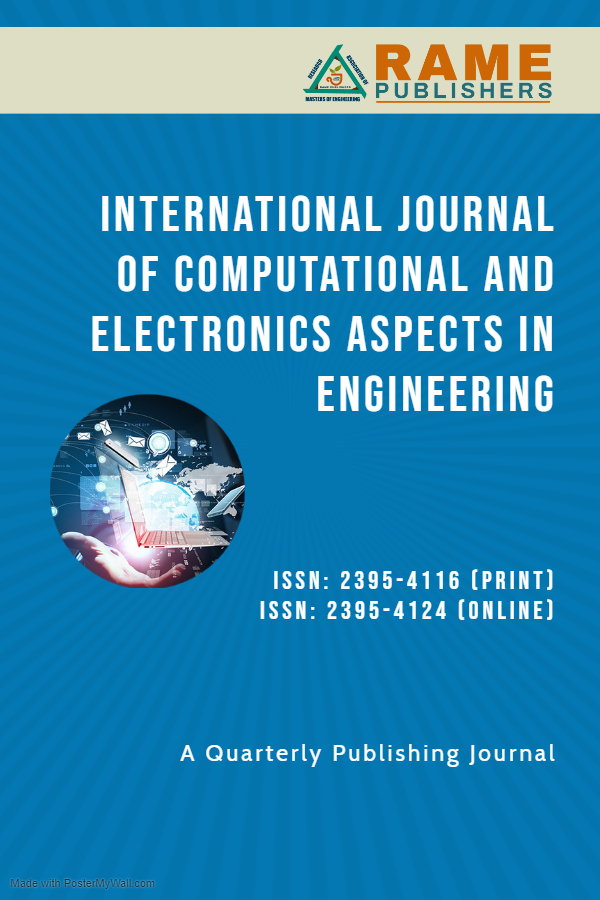Phoneme Based Approach for Transliteration of Konkani Language
Sushma R. Iliger, Soniya Usgaonkar
International Journal of Computational and Electronic Aspects in Engineering
Volume 3: Issue 2, June 2022, pp 13-17
Author's Information
Sushma R. Iliger2
Corresponding Author
2Department of Information Technology, Goa College Of Engineering, Margao, Goa, India
sushmariliger@gmail.com
Soniya Usgaonkar1
1Department of Information Technology, Goa College Of Engineering, Margao, Goa, India
Abstract:-
Simultaneously with the rise of machine translation, there has been a surge in the research field of machine transliteration. Despite the fact that the two processes are distinct and serve separate purposes, transliteration aids in the optimization of machine translation models. For languages such as Arabic, Korean, Japanese, Persian, Urdu, and Hindi etc, several methodologies have been developed. In this paper we present the implementation of the phoneme-based transliteration of Konkani scripture to Roman scripture using Direct Character Mapping technique and discuss the performance with respect to the ratings from a survey conducted from a small sample of Konkani speaking individuals. From the survey conducted we obtained an average score of 3.5 with respect to word accuracy.Index Terms:-
Transliteration, Phoneme based, Direct Mapping, Forward transliterationREFERENCES
- H. S. Priyadarshani, M. D. W. Rajapaksha, M. M. S. P. Ranasinghe, K. Sarveswaran and G. V. Dias, "Statistical Machine Learning for Transliteration: Transliterating names between Sinhala, Tamil and English," 2019 International Conference on Asian Language Processing (IALP), 2019, pp.244-249.
Crossref - Chinnakotla,Manoj K and Damani,Om P and Satoskar, “Transliteration for resource-scarce languages”, ACM, 2010.
Crossref - Arbabi, M.; Fischthal, S. M.; Cheng, V. C.; Bart, E.. “Algorithms for Arabic name transliteration”, IBM Journal of Research and Development, 1994 38(2), 183–194.
Crossref - Dhore, Manikrao & Shantanu, Kumar & Sonwalkar, Tushar. (2012). Hindi to English Machine Transliteration of Named Entities using Conditional Random Fields. International Journal of Computer Applications. 48.
Crossref - Singh, Shailendra & Sachan, Manoj. (2019). GRT: Gurmukhi to Roman Transliteration System using Character Mapping and Handcrafted Rules. International Journal of Innovative Technology and Exploring Engineering. 8. 2758-2763.
Crossref - Rajan, V.: Konkanverter - A Finite State Transducer based Statistical Machine Translitera-tion Engine Konkani Language. Proceedings of the 5th Workshop on South and SoutheastAsian NLP, 25th International Conference on Computational Linguistics, pp. 11–19. Irel-and (2014).
Crossref - Jong-Hoon Oh and Key-Sun Choi. 2002. An English-Korean transliteration model using pronunciation and contextual rules. In Proceedings of the 19th international conference on Computational linguistics - Volume 1 (COLING '02). Association for Computational Linguistics, USA, 1–7.
Crossref - Khantonthon, N., Kawtraku, A. and Poovarawan, Y. (2000), “An Enhancement of Thai Text Retrieval Efficiency by Automatic Backward Transliteration”, in proceedings of 7th International Workshop of Academic Information Networks on Systems, Bangkok, Thailand, pp. 73-84.
Online - Kevin Knight and Jonathan Graehl. 1997. Machine transliteration. In Proceedings of the 35th Annual Meeting of the Association for Computational Linguistics and Eighth Conference of the European Chapter of the Association for Computational Linguistics (ACL '98/EACL '98). Association for Computational Linguistics, USA, 128–135.
Crossref - J. Nair and A. Sadasivan, "A Roman to Devanagari Back-Transliteration Algorithm based on Harvard-Kyoto Convention," 2019 IEEE 5th International Conference for Convergence in Technology (I2CT), 2019, pp. 1-6,
Crossref - Rathod P H, Dhore M L and Dhore R M, (2013) “Hindi And Marathi To English Machine Transliteration Using SVM”, International Journal on Natural Language Computing (IJNLC) Vol. 2, No.4, pp. 55-71.
Crossref - TirthankarDasgupta, Manjira Sinha and Anupam Basu, “Forward Transliteration of Dzongkha Text to Braille,” Proceedings of the Second Workshop on Advances in Text Input Methods (WTIM 2), pp. 97–106, December 2012.
Online - K. Raju, T. V. Sreerekha, P. V. Vidya, R. R. Rajeev and P. C. Reghu Raj, "Tamil to Malayalam Transliteration," 2015 Fifth International Conference on Advances in Computing and Communications(ICACC),2015,pp.12-15,
Crossref - A. Murat, A. Yusup and Y. Abaydulla, "Research and Implementation of the Uyghur-Chinese Personal Name Transliteration Based on Syllabification," 2013 International Conference on Asian Language Processing, 2013, pp. 71-74,
Crossref - N. B. Jariwala and B. Patel, "Transliteration of Digital Gujarati Text Into Printable Braille," 2015 Fifth International Conference on Communication Systems and Network Technologies,2015,pp.572-577,
Crossref
To view full paper, Download here
To View Full Paper
For authors
Author's guidelines Publication Ethics Publication Policies Artical Processing Charges Call for paper Frequently Asked Questions(FAQS) View All Volumes and IssuesPublishing with




